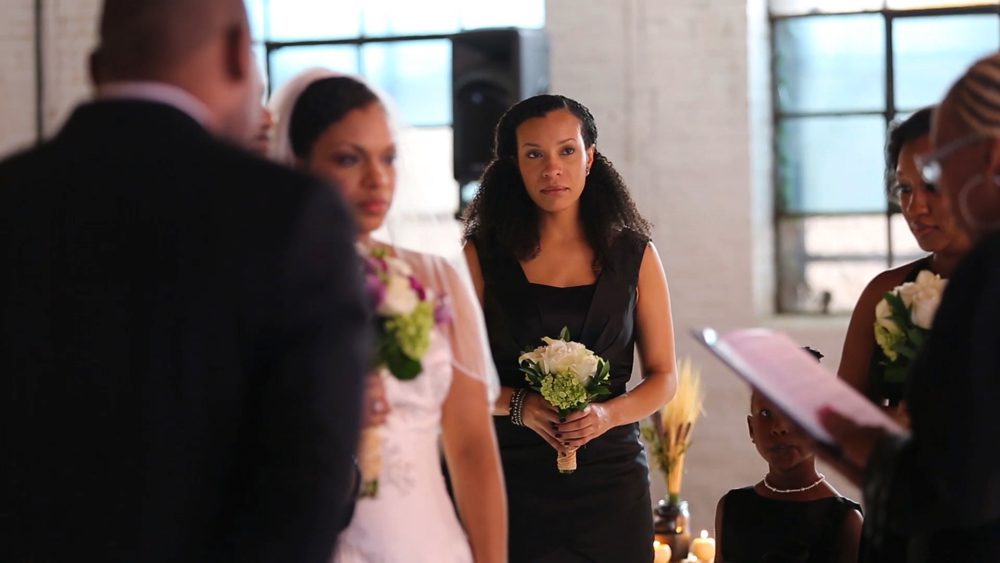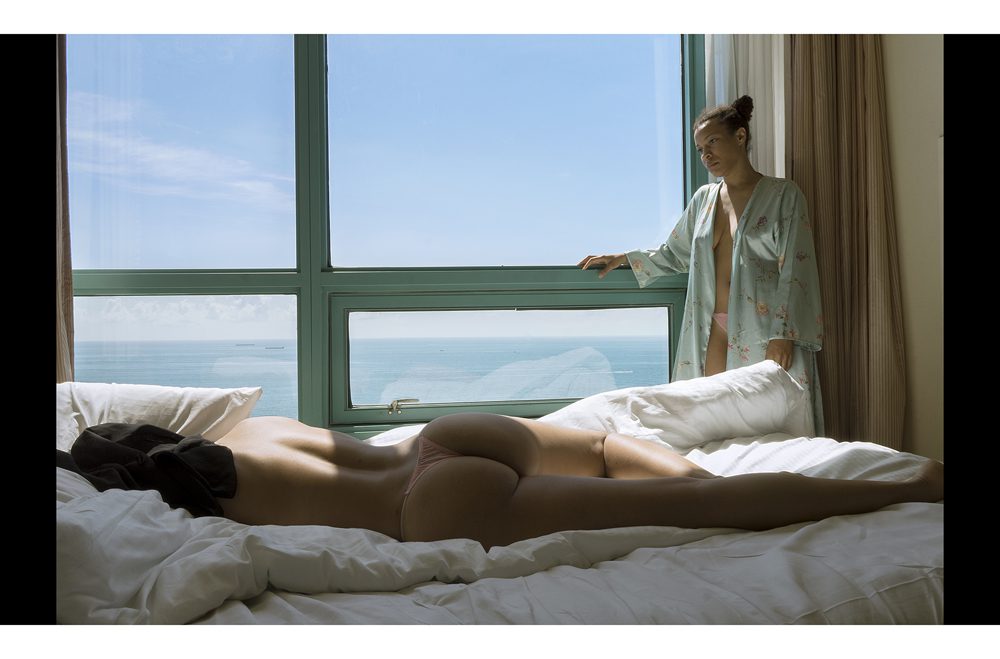The Real World: An Interview with Rashayla Marie Brown
Allison Glenn talks with Rashayla Marie Brown about the artist’s explorations of family and fame in a reality-TV series, which recently debuted at Aspect/Ratio in Chicago.

Rashayla Marie Brown, Reality Is Not Good Enough: Intro, 2016. Edited by Ashley Thompson. Single-channel HD video. Courtesy the artist and Aspect/Ratio, Chicago.
Editor's Note
Rashayla Marie Brown is an artist, activist, cultural critic, educator, writer, and self-proclaimed nomad. Often using her body as a source and subject, Brown works to reveal the performance of identity and the projection of cultural myths and desires within the collective consciousness. In the artist’s first solo gallery exhibition, “Can the Spectator Speak?” at Aspect/Ratio in Chicago, Brown debuted Reality is Not Good Enough, an artwork in the form of a reality-television show. The first episode explores the complicated connections between power and intimacy in female relationships, specifically focusing on the artist’s matriarchical family. I recently sat down with Brown to discuss the series and the ever elusive topics of love, trust, and fear.
—Allison Glenn
Allison Glenn: In Reality is Not Good Enough, we have the opportunity to experience intimate moments of your family life vis-à-vis the format of reality television. The choice to look inward to the domestic sphere places you in a long lineage of image-makers who focus on the vernacular home environment. What was the impetus for turning the camera toward your family? What are you looking to explore here?
Rashayla Marie Brown: I’ve worked with my family for quite some time. In fact, my first video, Gaze, 2011, was a collaboration between me and my mother. My family is very close, and I brainstorm ideas about my work with them on a regular basis. It’s a way for me to stay connected but also have them critically engage with the ideas that I’m interested in as an artist. I trust them to be rigorous, and they enjoy being a part of my world. Also, many of the popular reality-TV enterprises center on families, marriage, and contractual engagements between people who are related to each other.
AG: There’s a particular scene during your sister Abrina’s wedding ceremony that I’d like to unpack. The camera is focused on you, your mom has just walked Abrina down the aisle, and she is getting in place for the ceremony. Abrina seems distinctly unaware of the camera, and the soft focus further exacerbates the distance between her and the viewer. Conversely, you seem aware of the camera but your attention is focused on the ceremony. There is a moment where you give yourself away, glancing ever so slightly at the camera and then away again almost immediately. Blink and you’ll miss it, but it’s there.
RMB: I always know when a camera person is focusing on me. I don’t think it’s possible for me to be unaware, even when I’m intoxicated or distracted. I’m highly invested in looking at myself through the eyes of others, for better or for worse.
AG: Watching you through the lens of the camera, I feel compassion for you and a sense of love. Not to mention that the series is deliciously voyeuristic! How does your obvious knowledge of cinematic affect come into play here when filming scenes at family gatherings?
RMB: I think a lot about what it means to be moved. How do I create a sense of emotion? How do I pull my viewer out of their own assumptions? How do I compel them to feel and think their own way through the work? That’s the great thing about film and video in general. Viewers allow themselves to feel through the work and consciously suspend their disbelief in order to enter an unknown space of my making.
An excerpt from Rashayla Marie Brown’s Reality Is Not Good Enough: Intro, 2016. Edited by Ashley Thompson. Single-channel HD video. Courtesy the artist and Aspect/Ratio, Chicago.
AG: How much of the series are you directing, and how much liberty do you give Elizah, the camerawoman you charged with filming the series?
RMB: Elizah had total liberty to make whatever shots she wanted to make. I gave her very little direction during shooting. I wanted to see what she could do, and I trusted that she had the skills necessary. However, I directed everything. I created the social context, designed the plot, and introduced her to the family through descriptions before she ever met them. I think it was important not to give my collaborators too much information up front because part of the project is a social experiment. I want to know what the limits of intimacy are. When does the work cross a line that permanently damages our relationships or can the art itself actually make us closer than we would have ever been without it?
AG: Intimacy is a great point to further explore. In the wedding scene, where you are at once bold and vulnerable, a sense of intimacy is clearly articulated through the focus of the camera and Elizah’s gaze. She is looking at you, and you are looking directly at her through the camera. You cleverly return to this moment and flip it in the scene where you take over the camera and film Elizah sleeping. Can we talk about narcissism and desire here?
RMB: Sometimes the only way to get close to someone is through art or artifice. I love things and people that remind me of myself or something that I like about myself. That is not love of the other; it’s very selfish. In the installation for “Can the Spectator Speak?”, I also have a photograph of a woman sleeping in a bed, while I look at her. I feel very strongly that love of others is love of the self.
AG: It’s pretty remarkable that you were able to weave Elizah into the film and traverse the distance between the viewer and the subject. This is a move that I’ve seen in many different bodies of your work, like the aforementioned two-channel video Gaze. In that work, the audience has the opportunity to simultaneously view your performance on the left and your mother’s reaction to watching your performance on the right. This form presents your mother as the viewer and subject, collapsing the distance between the two. Can you speak to the conscious decision to bring Elizah and other members of the crew into Reality is Not Good Enough?
RMB: Dealing with people is very hard for me. Dating is really hard for me. Business relationships are very hard for me. I constantly test the boundaries of trust for both my viewers and my collaborators. Social contracts—such as those between the photographer and the subject or the concept of monogamy or responsible polyamory—fascinate me. Working with and around other people allows me to process how I’m feeling about my present circumstances, the necessity of working with and loving stubborn, difficult people.

Rashayla Marie Brown, Landscape for the Girls or Ex-Wives From the House of Yemanjá (After Audre Lorde) I Bear Two Women Upon My Back, 2016. Archival inkjet print. Courtesy the artist and Aspect/Ratio, Chicago.
AG: OK, so what actually happened at the wedding?
RMB: I think this is a question that can only be answered by watching the film. I think to interpret it for the audience would ruin the work. But to be simple about it, my sister got married! Also, my friend Vek, the other cameraperson, was my date to the wedding because he had already known my family for years. The family had some disagreements. My father and mother both walked my sister down the aisle, which came out of negotiations.
AG: During the confessional scene with your mom, the audience gets a chance to put the pieces together regarding the verbal altercation at Abrina’s wedding. There is a level of vulnerability in the characters that I relate to. There were moments that I cringed when a scene became too personal. How are you able to transcend the fear of awkward moments and move forward with creating the work?
RMB: I feel like I have to get past the fear. Fear never makes the work what it needs to be for anybody. My biggest job is explaining to my mother and sisters that I’m not trying to embarrass them and explain my vision as an artist. I think the next fear I have to resolve is the fear of allowing others’ opinions to overdetermine the work. I’m trying to allow them space to breathe, but, for a person who likes to be in control, it’s very hard.
AG: I can imagine that it’s extremely difficult. What was your editing process? Did you use it to balance these expectations?
RMB: I hired a video editor, Ashley Thompson, who shared my feminist vision for the series, to run through the entire project with me. I reviewed the footage and then went to her studio and we selected clips together. She did an edit, then I went back to her studio and we did that again. For this particular iteration, I think we did three or four back-and-forth passes.
AG: How has the use of voice-over and the reality-TV confessional informed the narrative?
RMB: Voice-over and confessional are all about forced intimacy, bringing you to the heart of the matter as directly as possible. However, they are also performances.
AG: Do you have anything to confess?
RMB: One thing I’d like to confess is that this project isn’t really about race or gender. It’s about love.
AG: I must confess that love’s been on my mind a lot these days.
Editor's Note
Rashayla Marie Brown’s “Can the Spectator Speak” is on view through August 20, 2016, at Aspect/Ratio, Chicago.



